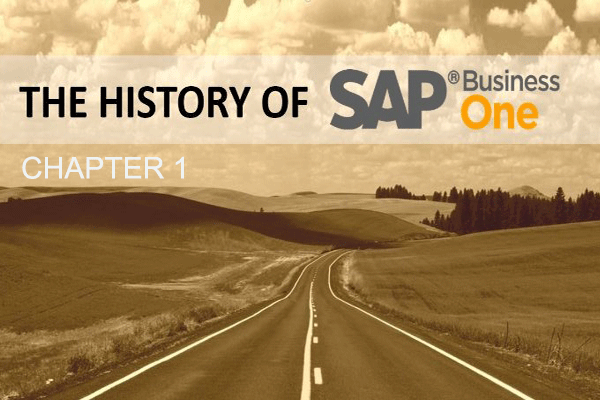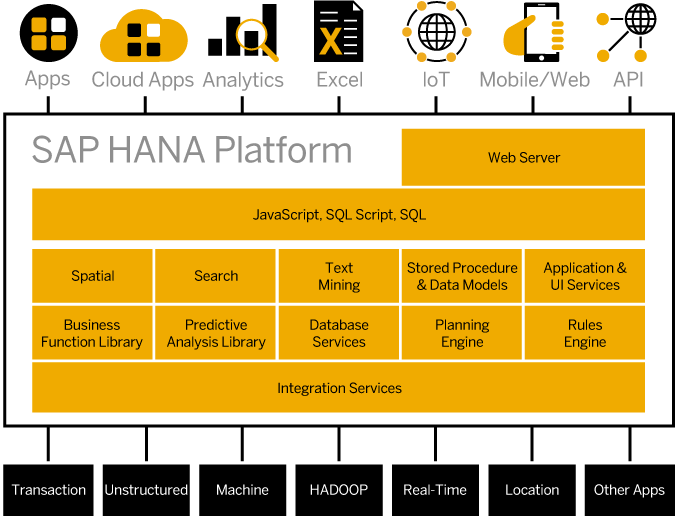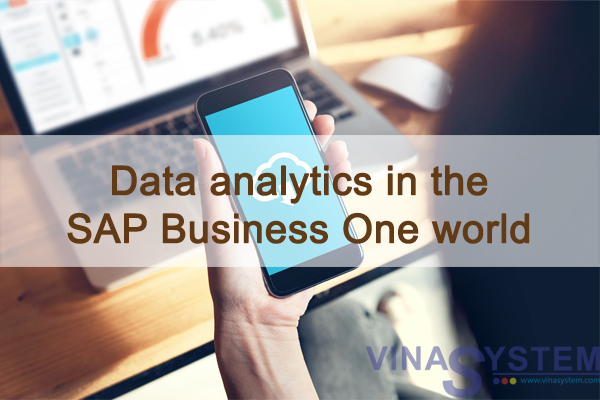
At the end of this topic, you will be able to:
- Answer the question: What is SAP Business One?
- Discuss the options available for running SAP Business One
- Describe the advantages of integrated business processes in SAP Business One.
You are the managing director of a small company and want to implement a new software solution to make your business processes more efficient.
You would like to learn more about SAP Business One and how you can use it to effectively run your business processes.
Specifically you want to see the advantages of integrated business processes.
I/ What is SAP Business One?

SAP Business One is a business management solution designed for small and midsize businesses.
SAP Business One gives you instant access to real-time information through one single system. The application is divided into a number of modules, each covering a different business function.
SAP Business One has a user-friendly interface that serves as your central ERP access point, with standard interfaces to internal and external data sources, mobile devices such as iPhone and iPad, and other analysis tools.
II/ SAP Business One: A True ERP System

SAP Business One represents a new breed of business software that is specifically designed to meet today‘s small and mid-size business needs and challenges. It completely removes the needs and problems associated with having disconnected business processes or systems:
It integrates and streamlines all business functions across sales, marketing, customers, financials and operations, all in a single system so your business operates like a seamless one
It stores all critical business information in one database so you can instantly access without having to get information from different systems that often do not agree with each other.
It provides built-in customer relationship management (CRM) tools that are fully integrated to the backoffice operations to help you better manage sales and customer services.
It is also a flexible system that can be easily customized and tailor to your own business and industry needs.
Last but not the least, SAP designed and built the product from the ground up, specifically for the small and mid-size businesses like yourself so you can leverage the best experiences and practices that SAP has learned over the past 40 years yet don‘t have to deal with the complexities.
III/ End-to-End Business Processes

Let us consider an example from a small business showing how SAP Business One provides integration among business processes:
Customers order custom-built personal computers.
Materials requirement planning (MRP) is run to determine what is needed to meet the customer demands.
From the MRP results, production orders are created to build the computers.
Materials are purchased for the components of the computer using the procurement process: purchase order, goods receipt PO and A/P invoice.
When the materials are received, they are issued as components to the production order.
The computer is built and we report the item as complete and receive it into finished inventory.
The serialized item is delivered to the customer. When it is issued, the system automatically creates a customer equipment record showing the sale to the customer and a service warranty contract.
If the customer has a future problem, a service call is created.
Based on the service warranty contract, there is a service level agreement for response and resolution time.
IV/ Options for growing businesses

If we look at the graphic from the bottom up, we see options that SAP provides for growing businesses.
SAP Business One runs completely on in-memory technology when you use the SAP HANA database as the underlying platform. However you also have the option to run on Microsoft SQL. Either way, you have flexible deployment options. You can run SAP Business One on-premise or in the cloud.
Regardless of the architecture used, end to end business processes are the core of SAP Business One.
There are many tools that enable partners and customers to build on or integrate to Business One. Functionality can be extended by using three development platforms: SAP Business One studio, the Integration Framework and the SAP Business One Service Layer. There are multiple partner and SAP-provided solutions to that extend the scope to meet companies’ needs. In the boxes in the graphics you see many ways you can enhance the solution such as industry solutions, web services, networks, mobility and analytic options.
Behind it all, there are tools and support for lifecycle management.
V/ Go global and enjoy local support

SAP Business One is used by customers in over 150 countries around the world in 27 languages.
While SAP provides 42 localizations for the product, our partners have adapted these localizations to fit the needs of many other countries.
Customers can go global while receiving support by partners that have deep, local knowledge and expertise.
VI/ Analytic Advantages of SAP HANA

SAP HANA can be a game changer for a business. It’s what lies underneath the application to make it possible to analyze the large amounts of data you have in real time. So instead of running a report and having to wait for the results, the calculation is done instantly, regardless of the amount of data involved, giving you immediate results and empowering employees to take action.
Unlike ERP systems of the past, SAP HANA’s power to crunch through data makes it easier for users to search for and find what they need using a Google-like freestyle search. This reduces the need to remember things like product numbers or customer numbers and lets you search Business One the way that you would use a search engine – with keywords. It’s an absolute time saver for users – where they don’t have to know all the ins and outs of the system but can get the information they need right away.
And it makes it possible to look at more data and do more sophisticated analysis and perform complex calculations, like we do with our SAP HANA apps. For example our advanced available-to-promise (ATP) app provides real-time visibility into current inventory, ordered stock, replenished stock, and stock being delivered. You can immediately reserve current stock for future delivery dates and reschedule existing orders on the fly to optimize product movement.
VII/ SAP Business One Options

Now we will look more closely at the options for running SAP Business One.
You can run SAP Business One, version for SAP HANA – in which both transactions and analytics run directly on the SAP HANA in-memory database.
You can run SAP Business One on SQL Server Database.
If you are running on the SQL server but need more analytical power, you can run SAP Business One, analytics on SAP HANA – which combines a system running on the SQL server database with an analytics server running on the SAP HANA in-memory database.
If you would rather not maintain your own on-premise solution, you can choose SAP Business One Cloud.
Lastly, there is the SAP Business One integration scenarios for integrating SAP Business One running in subsidiaries of a large enterprise with an SAP solution in the company headquarters.
Let us go through these solutions.
1/ SAP Business One, version for SAP HANA

In SAP Business One, version for SAP HANA, there is one appliance for both online transaction processing and for online analytical processing.
The entire SAP Business One database runs on SAP HANA.
As usual, the SAP Business One client connects each user to the SAP Business One server.
SAP HANA allows you to read around unwanted data by organizing tables in an efficient columnar manner. In addition to the common row-oriented storage schema a column-oriented data storage layout can be used. This means your application does not have to wait for the database to fetch data that it does not need as all the data in a table column is stored in an adjacent manner.
SAP HANA is also very competent at more traditional database data storage and access, e. g. row-oriented tables are also available. This combination of both classical and innovative technologies allows the developer to choose the best technology for their application and, where necessary, use both in parallel.
The transaction accelerator allows SAP HANA to run extreme applications that use the power of SAP HANA to enhance functions in areas such as cash flow management, availability to promise and delivery scheduling.
2/ SAP Business One on Microsoft SQL Server

Here we see our SAP Business One server on the Microsoft SQL server at the bottom. On top we see the SAP Business One client connecting to the SAP Business One server.
Each user has the SAP Business One client installed locally.
SAP Business One is based on a two-tier client/server architecture. Most of the application resides on the client ("fat client"). This means that processing is carried out locally and is largely independent of server performance.
3/ SAP Business One, analytics with SAP HANA

SAP Business One, analytics for SAP HANA adds analysis using the SAP HANA in-memory technology to an SAP Business One system running on the MS SQL Server database.
SAP HANA is an exciting new technology brought to you by SAP. At its core SAP HANA uses an innovative in-memory technique to store your data that is particularly suited for handling very large amounts of tabular, or relational, data with unprecedented performance.
Let us take a look at the architecture. On the left we see our SAP Business One server on the Microsoft SQL server. As always, the SAP Business One client connects each user to the SAP Business One server. All transactions will be done through the SQL server.
On the right we see a Linux server for the SAP Business One analytics.
Transactions and Master Data are replicated real-time from the SAP Business One database server to the SAP Business One analytics server. The data is stored in a columnar database using the in-memory technology.
On top of the transactional data in the SAP HANA database, there is a semantic layer containing views and cubes, and procedures, enabling analysis.
The SAP HANA Studio allows you to extend the semantic layer and develop new analytics.
You do not need to install anything specific within the Business One client to use SAP Analytics.
The box on the top right shows the components used for administration and designing analytics. The Administration console controls the Business One analytics server. The SAP HANA studio provides an environment for creating new views, new cubes, new procedures.
4/ SAP Business One Cloud

The SAP Business One Cloud solution allows multiple companies to share the same hardware resources while being isolated in a secure customer environment in a true hosting scenario.
End users access SAP Business One through the secure SAP Business One user cloud access portal or from their devices. Users see no difference logging in from what they would see with an on-premise solution.
Each tenant represents a company database, storage and licenses allocated for user by a customer’s enterprise. Customers may have multiple tenants across different service units, with each tenant having a different application version or purpose, such as productive, demonstration, or testing instances. Tenants share hardware and software resources , while storing their data in separate, secure databases.
Service Units are a collection of software components, servers and storage. All components in a single Service Unit are of the same SAP Business One version. Service Units contain multiple tenants from different customers.
Each Service Unit has multiple presentation servers that deliver the application to SAP Business One Cloud users.
5/ Integration Options

SAP Business One has two scenarios for integration in larger enterprises, both are based on the integration framework of SAP Business One.
- Option 1 integrates SAP Business One running in subsidiaries, branches or franchises of a large enterprise with SAP Business Suite or SAP Business All-in-One components running in the headquarters. Highlights include data harmonization, financial consolidation, business process standardization, and supply chain optimization. The solution comes with pre-configured scenarios and industry-specific content.
- Option 2 is an SAP Business One to SAP Business One integration allowing you to manage intercompany transactions between partner companies which are running different SAP Business One installations. Financial transactions and consolidation across SAP Business One systems is delivered out-of-the-box. Using this solution a company can automated complex business processes across their SAP Business One landscapes. You can use the integration framework to build your own integration scenarios or logic from the ground up or you can purchase the intercompany integration solution which is a pre-built pre-configured solution that can be tailored to your setup.
VIII/ Where To Find Additional Information

Your best source of information regarding SAP Business One is the global Partner Edge portal. You need to be an SME partner, customer, or employee of SAP to access the portal. There are also local portals available by country and region.
Ask your instructor for the most current link to the PartnerEdge portal. From here you can navigate to different areas that provide information about Solutions, Solution Development, Service & Support, Partnering with SAP, Marketing & Sales and Education.
Learn more about the SME Portal in the TB1200 SAP Business One – Implementation and Support course.
The SCN (SAP Community Network) is another resource for sharing information and community support for any interested persons. Anyone can register to be an SCN user.
IX/ Summary
Here are some key points:
- SAP Business One is an enterprise resource planning application (ERP) specifically designed for small business.
- It uses a two tier client/server architecture.
- SAP Business One can run on premise or in the cloud.
- Two options are available for the database: SAP HANA or MS SQL.
- You can use SAP HANA as the database for analytics using SAP Business One Analytics Powered by SAP HANA even If you are running MS SQL as underlying database.
- The SAP PartnerEdge provides the best source for up-to-date information on SAP Business One and support available from SAP.






